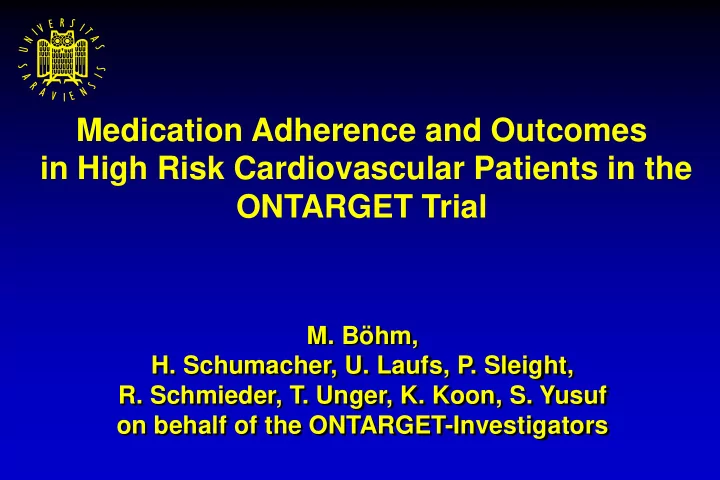

Medication Adherence and Outcomes in High Risk Cardiovascular Patients in the ONTARGET Trial M. Böhm, H. Schumacher, U. Laufs, P. Sleight, R. Schmieder, T. Unger, K. Koon, S. Yusuf on behalf of the ONTARGET-Investigators
Disclosures Authors were members of the ONTARGET Steering Committee and received honoraria and research grants from Boehringer Ingelheim as well as fees from other major cardovascular pharmaceutical companies
Background Nonadherence to medications - is a problem in high risk patients - associated with multidrug treatment - related to outcomes in several conditions - Hypertension - Hyperlipidemia - CAD - CHF - Associated with-health related life style characteristics („healthy adherer phenomenom“)
Objectives of ONTARGET Patients: CV high risk patients after MI, Stroke, PAD, or DM + 2RF Questions: 1. Is telmisartan “non - inferior” to ramipril? 2.Is the combination superior to ramipril? Outcome: 1.Primary: CV death, MI, stroke, CHF hosp 2.Key secondary: CV death, MI, stroke (HOPE trial outcome) 3.Single Components of the primary ONgoing Telmisartan Alone and in combination with Ramipril Global Endpoint Trial, Am Heart J 148: 52-61, 2004
Primary Outcome Telmisartan vs. Ramipril vs. Combination 0.20 Non-Inferiority Margin Cumulative Hazard Ratio 0.15 Primary Composite P=0.0045 Telmisartan Ramipril Combination 0.10 CV Death / MI / Stroke P=0.001 (HOPE Composite) 0.05 0.8 0.9 1.0 1.1 1.2 RR (95% CI) Telmisartan better Ramipril better 0.0 0 500 1000 1500 Follow-up (days) ONgoing Telmisartan Alone and in combination with Ramipril Global Endpoint Trial, N Engl J Med 358: 1547-1559, 2008
Objective of Current Analysis - Identification of patient characteristics for nonadherence - Effect of nonadherence on outcomes - Effect of CV-outcomes on adherence
Definitions and Methods Nonadherence: Complete and Permanent Discontinuation of All Study Medications Statistical Analysis: - differences tested by Chi-square (categorical) or Student`s t-test (continuous) - Cox propotional hazard model - nonadherence as time-dependent covariate - multiple regression - p<0.01
Permanent Stop of Study Medication Continuously Increased Over Time 0.25 4629 patients discontinued 0.20 Proportion of Patients 0.15 0.10 0.05 20.991 adherent 0.00 0 360 720 1080 1440 1800 2160 Days of follow-up
Cox Regression on Time to Permanent Stop of Study Medication (Non-Adherence, adjusted) Variable Pr > ChiSq HR 95% CI (1.030 – 1.039) Age, linear <0.0001 1.035 (1.117 – 1.289) Female vs Male <0.0001 1.200 (1.115 – 1.521) Black vs White 0.0009 1.302 (0.511 – 0.639) Asian vs White <0.0001 0.569 (0.574 – 0.726) Other vs White <0.0001 0.645 Activity 2- 6/week vs ≤ 1/week (0.804 – 0.927) <0.0001 0.863 Every day vs ≤ 1/week (0.750 – 0.865) <0.0001 0.806 (1.080 – 1.316) Smoking Current vs Never 0.0005 1.193 (1.038 – 1.192)) Smoking Formerly vs Never 0.0026 1.113 (0.974 – 1.128) Stroke / TIA 0.0013 1.128 (0.927 – 1.104) History of diabetes <0.0001 1.223 (0.867 – 1.036) Episodes of depression <0.0001 1.111 Age, Gender, Ethnics, Physical Activity, Smoking, Diabetes, neuro-psychiatric disorders
Distribution of Premature Permanent Discontinuations of Study Medication - By Time Permanent Cumulative Cumulative discontinuation Frequency Percent Frequency Percent < 6 weeks 354 7.7 354 7.7 585 12.6 939 20.3 6w - < 6 months 6m - < 1 year 619 13.4 1558 33.7 1y - < 2 years 1038 22.4 2596 56.1 785 17.0 3381 73.0 2y - < 3 years 3y - < 4 years 613 13.2 3994 86.3 ≥ 4 years 635 13.7 4629 100.0
Nonadherence Increases Overall Event Rates
Rapid Increase of Events by Year After Permanent Discontinuation of Study Medication
Rapid Increase of Events by Year After Permanent Discontinuation of Study Medication
Cox Model with Time-Dependent Covariate Time-dependent (HR for being off medication) p Hazard Ratio (CI) 1.298 (1.181 – 1.427) 4-fold endpoint <.0001 1.385 (1.255 – 1.528) 3-fold endpoint <.0001 2.050 (1.824 – 2.303) CV death <.0001 1.043 (0.866 – 1.256) MI 0.6569 1.066 (0.879 – 1.293) Stroke 0.5171 1.464 (1.228 – 1.745) CHF Hospitalisation <.0001
Rate of Rise of Event Rates after Stop of Study Medication is Similiar Between Years of Discontinuation 4-fold Endpoint 0.25 (CV-Death, MI, Stroke, CHF-Hospitalisation) 0.20 Proportion of Patients 0.15 0.10 No Discontinuation <1 year 1 - <2 years 2 - <3 years 0.05 3 - <4 years ≥ 4 years 0.00 0 365 730 1095 1460 1825 2190 Days of follow-up
Risk for Discontinuation of Medication is Increased After Nonfatal Primary Event
Risk for Discontinuation of Medication is Increased After Nonfatal Other Events
Number of Events Increases Nonadherence % 100 Adherence 90 No adherence 80 70 60 50 40 30 20 10 0 ≥ 4 None 1 2 3 Events
Patients with an Early Event Have Worse Mean Adherence Rates 90 4-Fold Endpoint 3-Fold Endpoint 85 Stroke Rate of Adherence (%) CV-Death 80 Myocardial Infarction CHF 75 70 65 60 ≥ 4 years No Event 3 - <4 years 2 - <3 years 1 - <2 years <1 year
Conclusions: - Ageing, females, ethnics, low physical activity, smoking, diabetes, neuro-psychiatric disorders are predictors of nonadherence - becoming nonadherent rapidly increases events - the event itself reduces adherence leading into a vicious cycle!
Concept: Nonadherence-Event Vicious Cycle Age, Gender, Ethnics, Physical Activity, Smoking, Diabetes, neuro-psychiatric disorders
Concept: Nonadherence-Event Vicious Cycle Age, Gender, Ethnics, Physical Activity, Nonadherence Smoking, Diabetes, Neuro-psychiatric disorders
Concept: Nonadherence-Event Vicious Cycle Age, Gender, Ethnics, Physical Activity, Nonadherence Smoking, Diabetes, Neuro-psychiatric disorders Events
Concept: Nonadherence-Event Vicious Cycle Age, Gender, Ethnics, Physical Activity, Nonadherence Smoking, Diabetes, Neuro-psychiatric disorders Increased Morbidity, Less Trust in Therapeutic Interventions Events
Concept: Nonadherence-Event Vicious Cycle Age, Gender, Ethnics, Physical Activity, Nonadherence Smoking, Diabetes, Neuro-psychiatric disorders Increased Morbidity, Less Trust in Therapeutic Interventions Events
Concept: Nonadherence-Event Vicious Cycle Age, Gender, Ethnics, Physical Activity, Nonadherence Smoking, Diabetes, Neuro-psychiatric disorders Increased Morbidity Less Trust in Therapeutic Interventions Need for specific Events Interventions!
Thank You! M. Böhm Innere Medizin III (Kardiologie / Angiologie / Internistische Intensivmedizin) Universitätsklinikum des Saarlandes Homburg/Saar
Recommend
More recommend